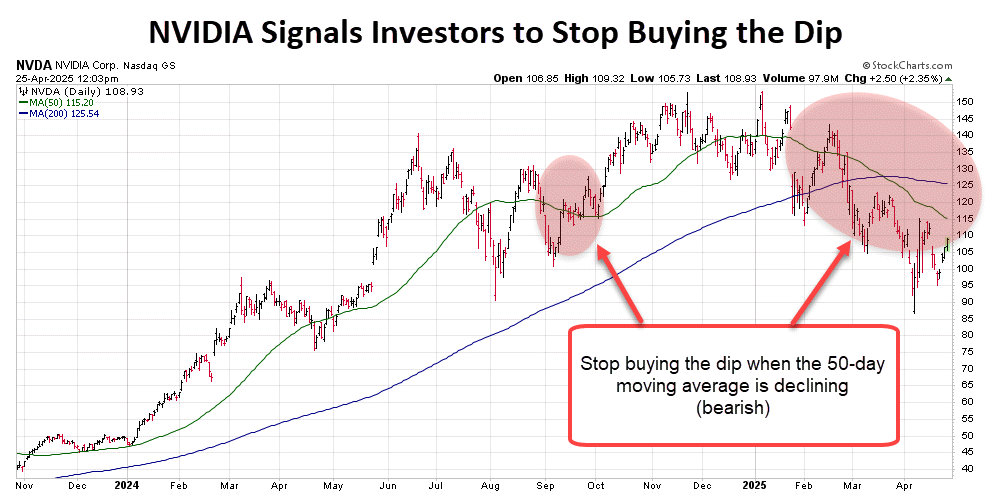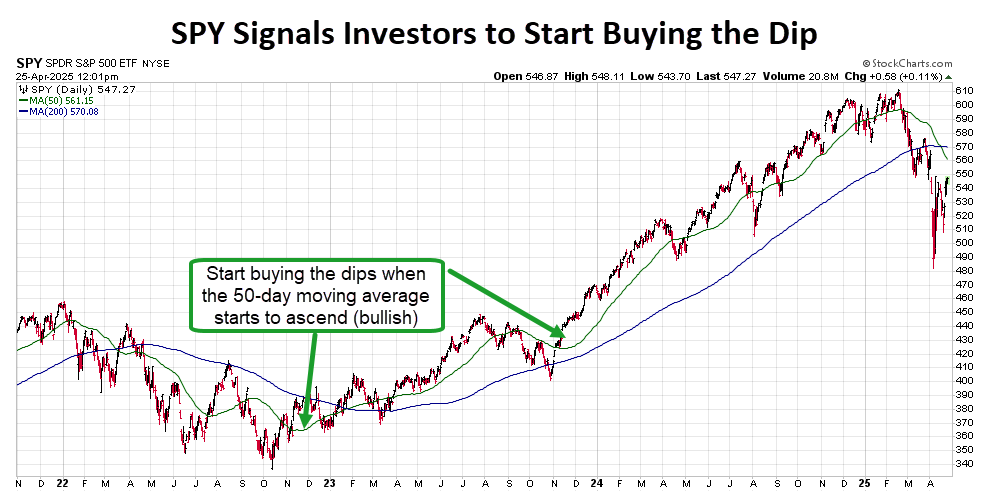How We Got Here
For months, investors have been aggressively buying every dip. In early April, reports from JP Morgan and Fidelity highlighted that retail trading activity was still consistent with a “buy the dip” mindset. This wasn’t surprising at first—after all, from December through January, stocks maintained their bullish trends, offering short, manageable pullbacks that rewarded those buying in.
But something happened in late January. The tides—or more accurately, the trends—shifted. Slowly, steadily, the 50-day moving averages on stocks like NVIDIA, Microsoft, and countless others began to turn lower. This wasn’t a subtle warning; this was a clear, quantified signal that the trend was no longer your friend.
Yet the dip buyers pressed on.
They kept pouring good money into a bad market, convinced that every 5-10% drop was another buying opportunity. But the rules of the game had changed. Buying the dip in this environment wasn’t savvy—it was self-sabotage.
Why Buying the Dip Can Be Dangerous
Buying the dip isn’t just about price action—it’s about sentiment. And sentiment is a crucial factor in how markets behave, especially in a bear market.
In bull markets, optimism reigns. Investors expect good times to continue, and buying the dip becomes an act of faith in the long-term strength of the market. But bear markets are different beasts. They cycle through distinct phases of sentiment—from denial, to hope, to fear, to disgust.
When stocks fall and you instinctively buy the dip, you’re expressing hope. And here’s the thing: hope has no place in a bear market. Not yet.
History tells us that bear markets don’t end when people are hopeful. They end when hope is extinguished. When investors aren’t just nervous—they’re disgusted. When they’ve given up entirely on stocks and are liquidating everything for cash or gold. Only then does a true bottom form.
Look no further than NVIDIA as a case study. In early January, its trend shifted—its 50-day moving average turned bearish. Since then, the stock has fallen more than 30%. Dip buyers, convinced they were snagging bargains, have compounded their losses with every subsequent decline. They’ve been trying to catch a falling knife—and getting cut every time.
 The bottom line is simple: Stop buying dips when the trend is no longer your friend.
The bottom line is simple: Stop buying dips when the trend is no longer your friend.
The Slope of Hope
Markets don’t just fall off a cliff in bear markets—they slide down what’s called a slope of hope. This phrase is the mirror image of the bull market adage, “the market climbs a wall of worry.”
In bull markets, despite all the fears and concerns, stocks manage to climb higher because of underlying strength. But in bear markets, even the occasional rally is underpinned by hope, not fundamentals. Every rally gets sold off, and stocks slide lower and lower as that hope gets chipped away.
And buying the dip fuels that hope. It keeps the market from reaching the necessary levels of fear and disgust that are required to flush out the weak hands and set the stage for a new bull market.
That’s why dip buying can be bad for the market itself. It delays the inevitable bottoming process by injecting optimism into a system that needs to purge it. Until that purge happens, stocks won’t bottom.
The Anatomy of a Bottom
Major market bottoms are never quiet affairs. They are loud, emotional, and filled with panic. The disgust phase of a bear market is marked by extreme selling, capitulation, and a wholesale rejection of risk assets. It’s not a time when people are nibbling on the dips—it’s a time when no one wants to own stocks at all.
Right now, we’re just beginning to approach that level. This week’s rally has shown some signs that dip buying enthusiasm is fading—trading volume remains suppressed, which is a positive sign. But we’re not there yet. There are still at least two phases to go through before we see a sustainable bottom in this market.
1. Acceptance
As we move into early summer, we’ll likely enter the acceptance phase. This is when investors finally acknowledge that stocks aren’t just having a bad week or month—they’re in a bear market. Selling pressure stays consistent, and stocks drift toward new lows.
2. Disgust
After acceptance comes disgust. This is the true bottoming phase, where investors throw in the towel. They sell everything, swear off stocks, and move their money into cash, gold, or even bury it in the backyard. This is when markets become extremely oversold, and sentiment hits rock bottom.
That’s the moment when buying the dip works again.
What to Do Instead
The hardest thing to do as an investor is nothing. But that’s exactly what this market demands. Simply wait.
It’s okay to miss the first 5% of a new bull market. I always say that giving up the first 5% of the rally is far better than trying (and failing) to time the exact bottom. You’re not going to catch it perfectly and trying to will only exhaust your capital and your confidence.
Wait for the signs. The real signs.
You’ll know it’s time to buy the dip again when the S&P 500’s 50-day moving average turns bullish, signaling a real trend reversal. Until then, stay patient.
 This bear market is still unfolding. Let it run its course.
This bear market is still unfolding. Let it run its course.
Stop buying the dip—unless you want to stand in the way of stocks finding their bottom.
— Chris Johnson
Your 12 income checks supercharged with 21% yields [sponsor]Imagine having 12 new monthly income checks, carrying the potential of up to 21% yields.This is possible because of a tested strategy to get paid out regularly, like a paycheck. For over a decade, I have helped more than 26,000 investors secure 12 new monthly payouts. Meaning, you know exactly how much you'll make every month... Because of some stocks that pay us 8%,13.4%, and even 21.6% yields. See it for yourself here.
Source: Money Morning

